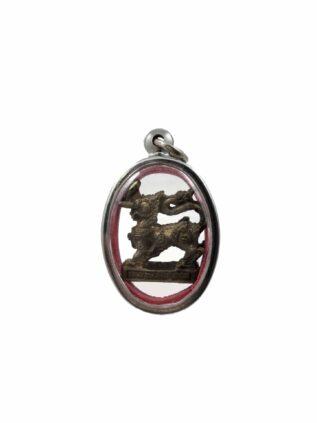Phra Singha
The Singha amulet is one of the most revered and symbolically rich talismans in Thailand, deeply intertwined with the country’s cultural and spiritual beliefs. The Singha, a mythological lion-like creature, occupies a significant place in Thai Buddhism and folklore, representing power, leadership, and protection. These qualities have made the Singha a popular figure not only in religious contexts but also as a protective and empowering emblem for those who wear its amulet.
In Thai culture, the Singha is a guardian figure. Much like a lion in the wild, the Singha is perceived as a strong protector of both physical spaces and spiritual realms. For this reason, the amulet is often worn by individuals seeking protection from harm, whether it be physical dangers, ill intentions, or malevolent spirits. The belief is that the amulet serves as a spiritual barrier, guarding its wearer much like the mythical creature defends its territory. In this sense, the Singha amulet functions similarly to other protective talismans in the Buddhist tradition, warding off bad luck and misfortune while promoting personal well-being.
More than just a protective symbol, the Singha is also a representation of leadership and authority. In Thai culture, the lion is seen as a natural leader of the animal kingdom, embodying strength, courage, and dominance. These traits are passed on to the wearer of the Singha amulet, making it especially popular among individuals who aspire to strengthen their personal power and confidence. Whether used by people in leadership positions or by those wishing to cultivate such traits, the Singha amulet is thought to enhance one’s ability to make decisive and righteous choices. It helps the wearer exude an aura of authority and moral strength, qualities highly valued in both personal and professional life.
The design of the Singha amulet is equally important in its spiritual significance. Often depicted either standing or sitting, the Singha is portrayed with a regal bearing, which reflects its association with royalty and nobility in Thai mythology. In many cases, the amulet is adorned with intricate details, sometimes featuring sacred yantra or geometric symbols that are believed to enhance its protective and empowering properties. These details imbue the amulet with additional layers of meaning, tying the wearer to the spiritual traditions of the monks or temples that bless and craft the amulet.
Culturally, the Singha has a long history in Thailand, particularly in its northern regions, where the creature holds a prominent place in Lanna culture. In ancient Thai myths, the Singha was considered a divine being with links to royalty, symbolizing the strength and virtue of kings. It was not uncommon for rulers to be compared to the Singha, embodying the ideals of courage, leadership, and justice. Today, this legacy continues in the form of amulets, which carry the same values into the modern world, allowing ordinary people to connect with this rich cultural heritage.
Ultimately, the Singha amulet is more than just a symbol of protection. It represents a way of life, emphasizing the importance of strong moral character, leadership, and integrity. For those who wear it, the amulet offers a means of connecting with the deeper spiritual and cultural traditions of Thailand, bringing with it the strength, courage, and protection of the mythical lion. In this way, the Singha amulet serves as a powerful reminder of the values it represents, offering both spiritual and practical benefits to those who carry it.
Showing the single result
Showing the single result

